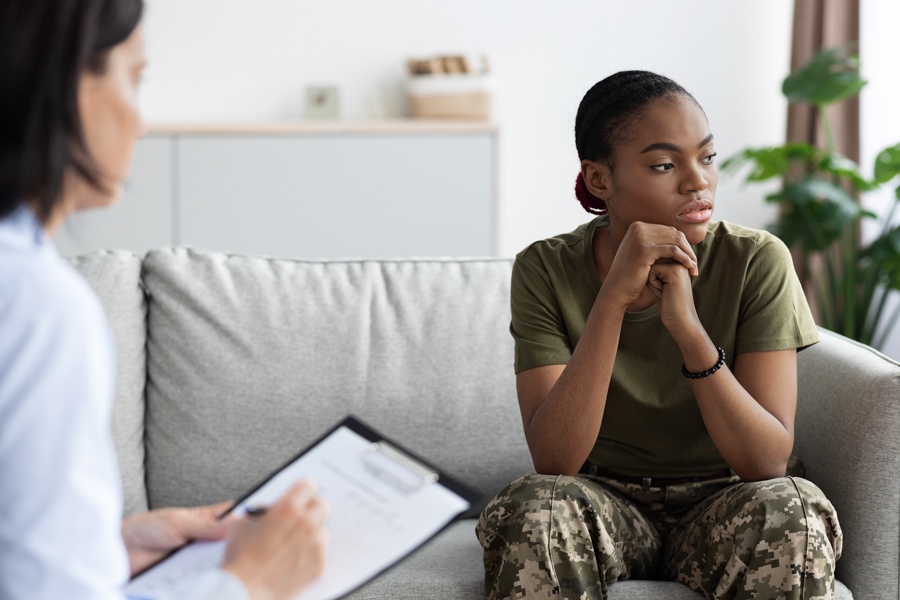If you have post-traumatic stress disorder (PTSD), you may experience recurring symptoms (symptoms that come and go regularly). You may go long periods feeling perfectly fine, then out of nowhere you feel scared, anxious, or angry. This can happen when certain stimuli remind you of a traumatic event that you went through or witnessed. These reminders are called triggers, and they can make you feel like you’re reliving the trauma all over again.
Triggers can be anything that your senses pick up, such as sights, sounds, smells, tastes, or feelings, and they can also be thoughts or emotions that you have. Some triggers are obvious, like seeing a news report about a similar trauma. Others are less clear, like seeing a certain color or hearing a particular song. Triggers are different for everyone, and they depend on what you experience and how your brain processes them. Learning to recognize your triggers can help you cope better with your PTSD and avoid situations that might make you feel worse.
What Is PTSD?
Jump to Section
PTSD stands for post-traumatic stress disorder, which is a mental health condition that some people develop after experiencing or witnessing a shocking, frightening, or dangerous event. PTSD can cause symptoms such as flashbacks, nightmares, anxiety, avoidance, and negative thoughts or feelings. These symptoms can last for months or years and interfere with your daily life and normal functioning. Post-traumatic stress disorder can be treated with medication and therapy programs.
What Are The Different Types Of PTSD?
There are different types of PTSD, depending on the type of event or events and the reactions a person has to them. Below are a few of the main types of PTSD:
- Normal stress response. This is a set of natural psychological, behavioral, and physical reactions that allow a person to deal with a stressor at hand. You may experience this response when facing an event such as a major illness or surgery, a high amount of pressure, or an accident. This type of response does not often have long-term effects or disrupt day-to-day life.
- Acute stress disorder. This is a disorder that can develop after a life-threatening event. Symptoms usually start between 3 days and 1 month after the event. Symptoms are similar to PTSD, but they usually go away within a month. If they don’t, a person may be diagnosed with PTSD.
- Uncomplicated PTSD. This is a disorder that is typically linked to a single traumatizing event or trauma that occurs within a brief period, such as a car accident, serious injury, or being diagnosed with a life-altering illness. This is the most common type of PTSD and effects about 3.4% of adults in the US.
- Complex PTSD. This is a disorder that is linked to multiple or prolonged traumatic events, such as childhood abuse, domestic violence, or war. This type of PTSD can cause more severe and persistent symptoms, such as difficulty regulating emotions, feeling detached from oneself or others, or having a distorted sense of self or reality.
- Comorbid PTSD. This is a disorder that occurs when a person has PTSD and another mental illness, such as depression, anxiety, or substance use disorder. This type of PTSD can make both conditions worse and harder to treat.
What Factors Has PTSD Been Linked To?
PTSD can be linked to many factors that affect how a person reacts to a traumatic event. The factors can include:
- The type and severity of the trauma. Some events are more likely to cause PTSD than others, such as sexual assault, combat, torture, or natural disasters. The more intense, prolonged, or life-threatening the trauma, the higher the risk of PTSD.
- The personal history and characteristics of the person. Certain people are more vulnerable to PTSD because of their genetics, personality, or previous experiences in their lives. For example, having a family history of mental illness, a history of abuse or neglect, or a pre-existing mental health condition can increase the risk of PTSD.
- The social and environmental support of the person. A few people are more resilient to PTSD because of their coping skills, beliefs, or relationships. For example, having a positive outlook, a strong sense of self, or a supportive network of family and friends can reduce the impact of trauma and promote recovery.
The presence of these factors does not guarantee that someone will develop PTSD.
Which Four Symptoms Would An Individual Need To Be Diagnosed With PTSD?
To be diagnosed with PTSD, you must meet numerous criteria outlined in the DSM-5, which is a manual used by doctors and psychologists to diagnose mental disorders. Receiving a diagnosis of PTSD requires you to have at least one re-experiencing symptom, one avoidance symptom, two negative alterations in mood and cognition, and two hyperarousal symptoms. These symptoms must be caused by the traumatic event itself, and not by any other factor. Below are some examples of each type of symptom:
- Re-experiencing symptoms, such as flashbacks, nightmares, and bad memories are those that make you feel as though you are reliving the event.
- Avoidance symptoms are those that make you avoid certain places, people, and situations that trigger bad memories. You may also avoid thinking about or discussing the event and might go as far as changing your daily routine for this reason.
- Negative alterations in mood and cognition are those that make you have negative thoughts or feelings about yourself or the world. You may develop trust issues, feel guilty or blame yourself, or lose interest in things you used to enjoy.
- Hyperarousal symptoms are those that make you feel stressed, angry, or jumpy. You may have trouble sleeping or concentrating, be easily startled, or act in risky or unhealthy ways.
How Can I Know If I Have PTSD Triggers?
PTSD triggers are anything that reminds you of a traumatic event that you experienced or witnessed and causes you to have flashbacks, nightmares, anxiety, or other symptoms of PTSD. These triggers can be internal or external.
- Internal triggers are things that happen inside your body, such as thoughts, feelings, or sensations.
- External triggers are things that happen outside your body, such as sights, sounds, smells, or situations.
To determine if you have PTSD triggers, you need to pay attention to what happens before you have a PTSD symptom. You can do this by keeping a journal or using an app to track your mood, thoughts, and experiences throughout the day. Feel free to ask someone you trust, such as a friend, family member, or therapist, to help you notice and identify your triggers.
Being able to identify and recognize your triggers will help you learn to cope with them and reduce their impact on your life. You can also seek professional help if your triggers are too overwhelming or interfere with your daily functioning.
What Are Real-World Examples Of PTSD Triggers?
PTSD triggers can vary from person to person, but they normally stem from your senses, like your sight, your hearing, and your sense of smell. In addition, certain aspects of your lifestyle, such as not having enough social support, can worsen your PTSD triggers.
A few real-world examples of PTSD triggers are:
- Loud noises and crowds. These can trigger PTSD symptoms in people who have been exposed to war, violence, or explosions, and they may feel like they are back in a dangerous situation and experience fear, panic, or anger.
- Certain smells. These can trigger PTSD symptoms in people who have been sexually assaulted, abused, or tortured, and they may smell something that was present during the trauma, such as perfume, alcohol, or blood, and feel disgusted, violated, or ashamed.
- An anniversary. This can trigger PTSD symptoms in people who have lost a loved one, survived a natural disaster, or witnessed a tragedy. These people may relive the painful memories and emotions of the event, and feel sad, depressed, or guilty.
- A specific place. This can trigger symptoms of PTSD in people who have been in a car accident, a shooting, or a robbery. They may avoid or fear going to the place where the trauma happened and feel anxious, nervous, or paranoid.
These are the most common examples of PTSD triggers, but there are many others.
How Can I Cope With PTSD Triggers?
PTSD can affect anyone who suffers a traumatic event. When it first strikes, it can be very overwhelming and you may feel as if you will never be able to cope with the condition. Fortunately, there are ways you can manage the symptoms and severity of the triggers. Here are some tips on how to cope with PTSD triggers:
- Identify your triggers. Use a journal or an app to track your mood, thoughts, and experiences throughout the day. You can also get your friends, family, or therapist involved with helping you notice and identify your triggers. Knowing your triggers will help you better avoid or prepare for them.
- Practice relaxation techniques. You can practice deep breathing, guided meditations, progressive muscle relaxation, or other methods to calm your body and mind. These are available techniques for daily use or whenever you feel stressed or triggered. Many apps, videos, and audio recordings can guide you through the process.
- Seek professional help. If your triggers are too overwhelming or interfere with your daily functioning, you may benefit from talking to a mental health professional about treatment options. Different types of therapy can help you cope with PTSD triggers, such as cognitive-behavioral therapy (CBT), eye movement desensitization and reprocessing (EMDR), or exposure therapy. You can also ask your doctor about medication options that can help with symptom management.
- Build a support network. You don’t have to cope with PTSD triggers alone. Reach out to people who care about you and understand what you are going through, and look into joining a support group, either online or in person, where you can share your experiences and learn from others who have PTSD. You can also use hotlines, websites, or apps that offer crisis support or peer counseling.
Free By The Sea Can Provide Trauma Therapy For PTSD Triggers
Free By The Sea is a recovery center that offers trauma therapy for people who have post-traumatic stress disorder (PTSD). Trauma therapy can help people with PTSD heal from their past and learn how to manage their triggers. Free By The Sea uses different types of trauma therapy, such as cognitive-behavioral therapy, eye movement desensitization and reprocessing, and family therapy.
These therapies can help people change their negative thoughts and feelings, process their trauma memories, and improve their relationships. Free By The Sea also offers addiction treatment, as some people with PTSD may use drugs or alcohol to cope. By treating both PTSD and addiction, Free By The Sea can help people recover from their trauma and live a healthier and happier life.
If you would like to schedule a tour of our facilities, speak with our admissions team about enrollment, or ask any questions about the services we offer, feel free to contact us today. We can help you begin the journey to recovery from PTSD and other mental health issues. Good health, both physical and mental, is a right that belongs to every one of us.

Dr. Richard Crabbe joined our team in 2019 as our psychiatrist and medical director. He attended the University of Ghana Medical School where he became a Medical Doctor in 1977. From 1978 through 1984, he was a medical officer in the Ghana Navy and provided a variety of services from general medicine to surgeries. He received his Certificate in General Psychology from the American Board of Psychology and Neurology in 2002.





